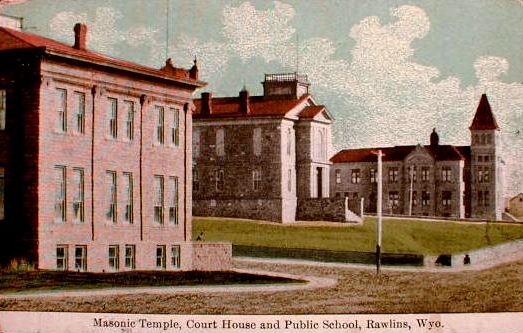
Rawlins, Wyo., 1910, L. to R. Masonic Temple, Court House, and
High School.
As is suggested by the photographs on this and the
preceding page, Rawlins at first was a bit wild.
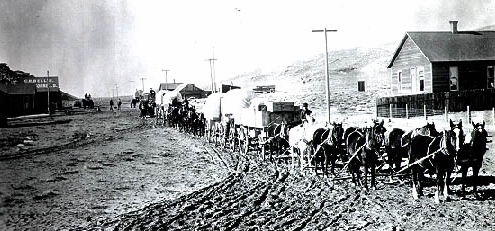
Undated photo of freighters in Rawlins.
In July 1878 the town became for a short
time the center of the scientific world when visitors from all over the world
descended upon the area for a total eclipse of the sun. Among those who came was
Thomas A. Edison who described his stay:
"There were astronomers from nearly every nation. We had a special car.
The country at that time was rather new; game was
in great abundance, and could be seen all day long
from the car window, especially antelope. We arrived
at Rawlins about 4 P.M. It had a small machine
shop, and was the point where locomotives
were changed for the next section. The hotel was a
very small one, and by doubling up we were barely
accommodated. My room-mate was Fox[1], the correspondent
of the New York Herald. After we retired
and were asleep a thundering knock on the door
awakened us. Upon opening the door a tall, handsome
man with flowing hair dressed in western style
entered the room. His eyes were bloodshot, and he
was somewhat inebriated. He introduced himself as
`Texas Jack'--Joe Chromondo--[sic][2]and said he wanted
to see Edison, as he had read about me in the newspapers.
Both Fox and I were rather scared, and
didn't know what was to be the result of the interview.
The landlord requested him not to make so
much noise, and was thrown out into the hall. Jack
explained that he had just come in with a party
which had been hunting, and that he felt fine. He
explained, also, that he was the boss pistol-shot of
the West; that it was he who taught the celebrated
Doctor Carver[3] how to shoot. Then suddenly pointing
to a weather-vane on the freight depot, he pulled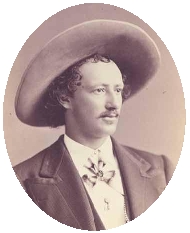 out a Colt revolver and fired through the window,
hitting the vane. The shot awakened all the people,
and they rushed in to see who was killed. It was
only after I told him I was tired and would see him
in the morning that he left. Both Fox and I were so
nervous we didn't sleep any that night.
out a Colt revolver and fired through the window,
hitting the vane. The shot awakened all the people,
and they rushed in to see who was killed. It was
only after I told him I was tired and would see him
in the morning that he left. Both Fox and I were so
nervous we didn't sleep any that night.
Above right,
John B. "Texas Jack" Omohundro, 1872, photo by Jeremiah Gurney & Son, see
notes below
"We were told in the morning that Jack was a
pretty good fellow, and was not one of the `bad
men,' of whom they had a good supply. They had
one in the jail, and Fox and I went over to see him. A
few days before he had held up a Union Pacific train
and robbed all the passengers. In the jail also was a
half-breed horse-thief. We interviewed the bad man
through bars as big as railroad rails. He looked like
a `bad man.' The rim of his ear all around came
to a sharp edge and was serrated. His eyes were nearly
white, and appeared as if made of glass and set in
wrong, like the life-size figures of Indians in the
Smithsonian Institution. His face was also extremely
irregular. He wouldn't answer a single question.
I learned afterward that he got seven years in prison,
while the horse-thief was hanged. As horses ran
wild, and there was no protection, it meant death
to steal one."
[Writer's notes: 1. Probably Edward Fox, correspondent for the New York Herald
in the 1870's.
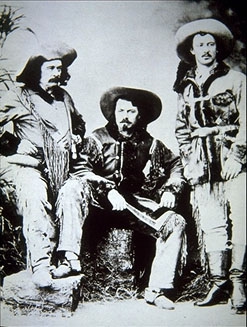
L. to R. Ned Buntline, Wm. F. Cody, John B. Omohundro, 1875
2. Reference to
Texas Jack is to John B. "Texas Jack" Omohundro (1846-1880). Omohundro was
born in Virginia and went to Texas at age 15. During the Civil War he returned
to Virginia and served as a scout for C.S.A General J. E. B. Stuart. He subsequently
returned to Texas and received the name "Texas Jack" on a cattle drive to
Tennessee. In the late 1860's he made the acquaintance of Wm. F. Cody, James Butler "Wild Bill" Hickok,
and Ned Buntline in Kansas. He returned east with Cody and Buntline and starred
in a Wild West Show, Scouts of the Prairie, and was later made famous, together with
Cody and Hickok, in some of Buntline's Dime Novels. In 1872 Omohundro served along with
Wm. F. Cody as a guide for the Grand Duke Alexis on his hunting trip to
Nebraska and Wyoming. The same year he
participated as trail agent in the last successful Pawnee buffalo hunt. The government required that
an agent accompany Indians on hunts so as to preclude the Indians from
leaving their appropriate territory or harrassing settlers. In the
next hunt in 1873 an inexperienced agent was employed by the Pawnee Nation and
the hunt ended unsuccessfully at the Battle of Massacre Creek. Later Omohundro played
with Hickok in a touring drama Scout of the Plains. Omohundro died in Leadville in
1880. Cody paid for the stone grave marker marking his burial site.
Jeremiah Gurney (1812-1886) with his son, Benjamin, was one of the leading New York
photographers. Subjects included Mark Twain, the Prince of Wales, and the Archduke Alexis.
The studio also took a photo of the dead President Lincoln in his casket. Secretary of
War Stanton ordered all copies destroyed. Benjamin Gurney is credited with inventing
the "Imperial" size carte de visite.
3. Doctor Carver, "Doctor" William F. Carver, a well known exhibition trap shootist who toured with
Cody's Wild West Show, now most famous as the inventor of the "Diving Horse" act
in Atlantic City, N. J., in which a horse and scantly clad young lady would dive from a forty-foot high
platform into a 12-foot deep tank. For photo and more on Carver, see Wyoming State Fair.]
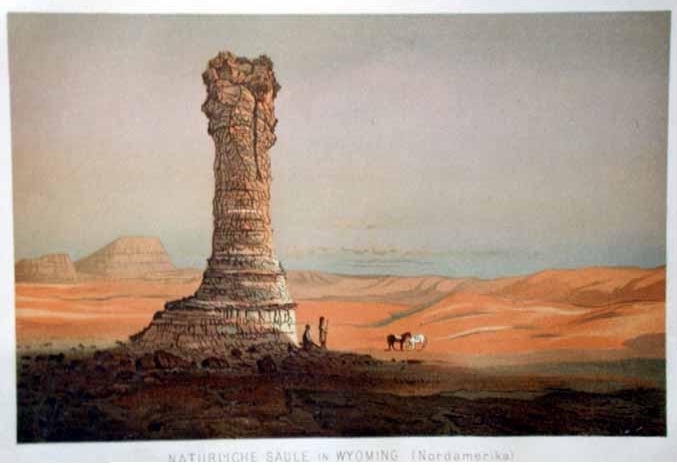
Natural Piller, Washakie Badlands, chromolithograph by Julius Bien from a
drawing by Gilbert Munger, Clarence King's 40th Parallel Geological Survey, 1869
Clarence King (1842-1901), a California geologist, in 1869 began a geological survey across the
west along the 40th parallel. Gilbert Munger (1837-1903) was the expedition's guest artist. Due to his
knowledge of geology, Clarence King is today remembered as the one who exposed one of the
great business frauds of the 19th Century. The fraud also left one of the great unsolved mysteries of Wyoming.
To the west of Baggs and southwest of Rawlins in southeastern Sweetwater County lies a desolate
area known as the Washakie Basin. Today most of the area is accessible only by occassional Jeep trails, and those
are few and far between. The appearance of the area can be pictured in the mind's eye by the place names of the Basin:
"Washakie Badlands," "Poison Draw,"
"Hells Canyon," "Poison Basin," "Colloid Draw, and "Poison Buttes."
In 1872, in this area, John Slack and John Arnold reported the
discovery of a rich diamond field. In order to convince potential investors of
the legitimacy of the find, a well-known and respected engineer and some of
the investors were brought to Rawlins and taken on a three-day trek, blindfolded so that would not
know where they were, to a lonely butte.
There they were shown the diamond field with diamonds everywhere, under the ground, in
rock crevices and on the surface waiting to be picked up. The engineer reported that $1,000,000 a month could be expected from a mining
operation. Stock was sold netting Slack and Arnold some $600,000.00. One of the investors was
the founder of the Bank of California, William Ralston. Ralston was already over extended and was attempting
to recoup his prior losses.
Unfortunately for the investors, Clarence King, due to his
knowlege of the area, was able to deduce the location, examined the site, and, with his knowlege of
rocks, determined that some of the diamonds were cut and
polished. At the same time, Ralston's partner, William Sharon, was attempting to break the backers of
a rival bank who were heavily invested in Virginia City, Nevada, mining. Sharon began dumping
Virginia City mining stock. Ralston was heavily invested in Comstock Lode stock.
Thus, on Thursday, August 26, 1875, the dumping caused a run on
Ralston's bank. Upon closing at the end of the business day, the bank announced that it was
suspending operations until further notice. The next day, the bank's board of directors
asked for and received Ralston's resignation. Upon leaving the bank, Ralston walked the two
miles to the chilly waters of San Francisco Bay. His body was recovered at
North Beach. Officially he was deemed to have died of a stroke whilst swimming.
Investigation as to the diamonds found that the year before Arnold and Slack had purchased
some $40,000 worth of low grade diamonds in London. Arnold was arrested in Kentucky where he was
found with the proceeds of the stock sale. Slack was never found, leading to the
suspicion that he may have been done in by his partner. The site of the
diamond mine and the balance of the $40,000 worth of diamonds has never been
found. Some believe that the location may be near Vernal in Utah, others believe it to be in
northern Colorado, and yet others contend that it is not more than 40 miles from Rawlins. The irony is
that the state geological survey reports that there is a very real possibility of
diamonds in the state, but as a result of Slack and Arnold's fraud any interest
in diamond exploration in the state had been deterred for over 100 years.
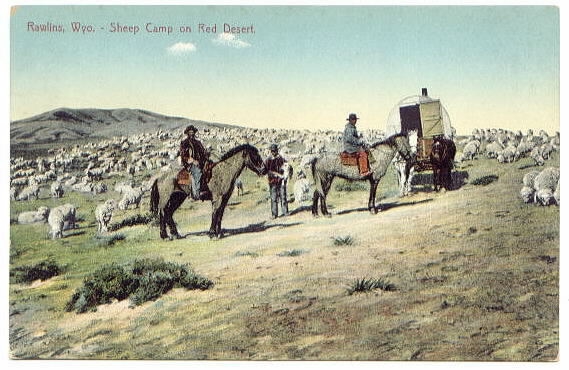
Sheep near Rawlins
With the coming of the railroad, Rawlins became a center of the sheep growing industry. Indeed,
if Cheyenne was the Holy City of the Cow, Rawlins was at least a minor Holy City of the Sheep.
Practically all of the City's early important
figures were involved one way or another with sheep. It has been contended that
the sheep wagon was invented in Rawlins by blacksmith James Candlish in 1884.
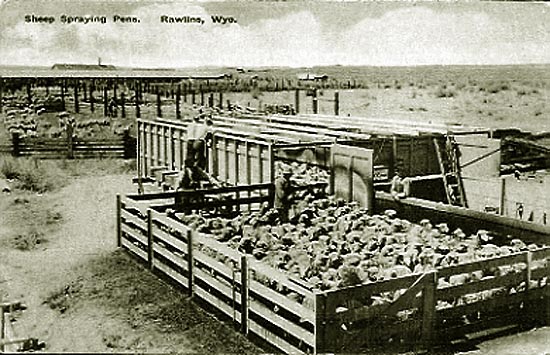
Sheep Spraying Pens, Rawlins.
The smell of sheep in Rawlins was pervasive. Weld County, Colorado, ranchman Frank Benton in his 1903
Cowboy Life on the Sidetrack complained:
We arrived at Rawlins, Wyoming, one bright sunny morning and planned to get a square meal
there and kinder clean up and take a shave.
But this was a sheep town and full of sheepmen and the odor of sheep was so
strong we just stopped long enough to fill our bottles and then sauntered on ahead of our
train, expecting to get on when it overtook us.
Pinkerton operative Charlie Siringo observed that even the cattlemen smelled of sheep:
I arrived in the hurrah little city of Rawlins, where half the men are railroad employes
and the other half, with the exception of the gamblers and saloon men, smell sheepy.
Even the cattlemen get to smelling like sheep from the constant chasing of sheep off their ranges.
Rawlins is the center of a great sheep country. Siringo, Charles A., A Cowboy Detective,
W. B. Conkey company, Chicago, 1912.
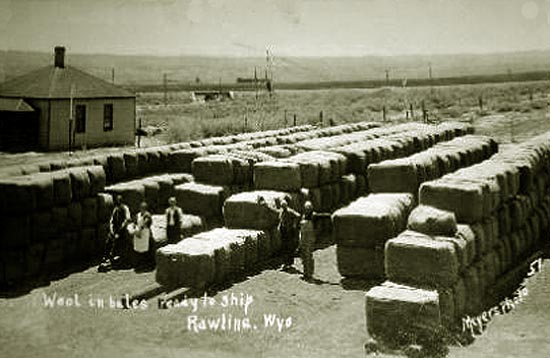
Bails of wool awaiting shipment, Rawlins.
As typical in a small community where many have an interest in the same industry, sides have to be chosen.
On one side were the Cosgriff Brothers with large sheep interests and their own
banks, and on the other former sheriff Isaac C. Miller who also had large sheep interests and, with John E.
Osborne, owned the Rawlins National Bank. In 1898 battle broke out between the Cosgriff Bothers and Miller over the issue of
open range and the acquisition of property in "checkerboard fashion" so as to preclude use
of land. By acquiring property in a checkerboard manner, one precludes access to the remainder of land in a
township. Generally speaking each township is six miles by six miles and contains
36 one-mile square numbered sections. As a part of the financing of the Union Pacific, it
was granted title to odd-numbered sections along the line of the road. The following diagram illustates:
| 6 |
5 |
4 |
3 |
2 |
1 |
| 7 |
8 |
9 |
10 |
11 |
12 |
| 18 |
17 |
16 |
15 |
14 |
13 |
| 19 |
20 |
21 |
22 |
23 |
24 |
| 30 |
29 |
28 |
27 |
26 |
25 |
| 31 |
32 |
33 |
34 |
35 |
36 |
Thus, it may be seen that if one acquires the odd numbered sections, access is precluded from
the interior even numbered sections. By this means several cattle companies in Colorado in
the 1880's gained control over millions of acres. The same methodology was used by
Gov. Baxter's Western Union Cattle Co. and led to his removal from office. For further discussion
of "checkerboard control," see Johnson County War.
Miller leased from the Union Pacific nineteen odd-numbered sections of land on which to winter his sheep.
The Cosgriff Brothers, on the other hand, relied on open range for the pasturing of their
sheep and drove their flocks onto Miller's lands where the sheep proceeded to strip the land bare of grass.
Three times Miller's foreman drove the Cosgriff sheep off. In response, Thomas Cosgriff armed his men for
the purpose of, in his own words, "the protection of the herds against the
deprivations of wolves in any form." The issue of checkerboard control over
government land was not resolved by the United States Supreme Court until 1979.
In that case, the Leo Sheep Company had barred public access to the
Seminoe Reservoir by its ownership of alternating sections. The Court held checkerboard control to be legal.
Next Page, Rawlins continued.
|